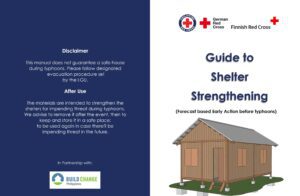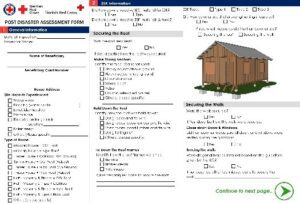
August 24, 2020
My Experience Designing Assessment Tools in Partnership with the German & Philippine Red Cross


Samantha Kay Lisay
Design Architect
One of my first projects with Build Change was to design forecast-based financing resources for the German and Philippine Red Cross. The aim of forecast-based financing is to use science or forecast models to identify where to give aid even before a disaster strikes. This specific project focused on lessening the damage to vulnerable housing caused by typhoons by temporarily strengthening them 2-3 days before the forecasted storm. Build Change was tasked with coming up with resources such as an assessment form, shelter strengthening guide, and a post-disaster assessment form to make this rapid strengthening response possible.
Designing Material Resources
As Build Change’s resident designer, I quickly jumped into creating these materials, only to realize that this was not an ordinary design challenge.
When designing the assessment form, we took into consideration the criteria for receiving the shelter strengthening kits (SSK), including the type and condition of the house. As a designer, it was my job to not only make things visually pleasing, but to make sure that a non-technical person could confidently and accurately evaluate a house and determine if it required strengthening or not.

For the shelter strengthening guide, it was really important that I work with Build Change engineers to come up with ideas about what a homeowner could do to reduce the damage to their house during a typhoon. It was quite a challenge, considering the strengthening had to be simple enough that a non-technical person, a nanay (mother) or tatay (father) for example, could understand and share this information with others. Also, the kit needed to be simple enough that it could be installed in just a few hours.

I enjoyed the process of thinking through this project with the team, brainstorming and imagining potential scenarios, with the goal of reducing damage and strengthening houses before disaster strikes.
Another important part of this project was creating a way to give feedback about how the shelter strengthening actually worked in the form of a post-disaster assessment. Again, the main consideration for this form was, “Could a non-technical person actually use this?” I’ve always thought that design should be client-centric, and in this case, user-centric. I also made sure that everything was technically correct, visually pleasing, and of above all, easy to use.

The Importance of Consultations and Field Tests

As with any design project, consultation and testing are extremely important. We may think we have a good design, based on our standards, but the people who will actually be the end-users should always be consulted, and the methods we propose must be tested on-site. For this project, Build Change held focus group discussions with the Philippine Red Cross staff and ran field tests in which we vetted our planned approach. Out of these sessions came a lot of great feedback, that I was personally grateful for, even though it meant that I had to go back and make several rounds of edits. Many revisions and discussions later, we produced the final resource materials, and I’m proud of the process and end result. The final product is truly a design produced through collaboration between Build Change, our Red Cross clients, and our users in the community. I look back on my experience designing for the Red Cross fondly, and I always try to remember some of my personal lessons learned: that materials must be technically sound, and always vetted and field-tested with our clients and users. This is the only way to make sure the people that most need these resources ultimately use them when their lives and homes are at stake.
Support resilient housing worldwide
Join us in preventing housing loss caused by disasters.
Donate nowNewsletter
Sign up for our newsletter to receive updates on our latest news, events, and more.